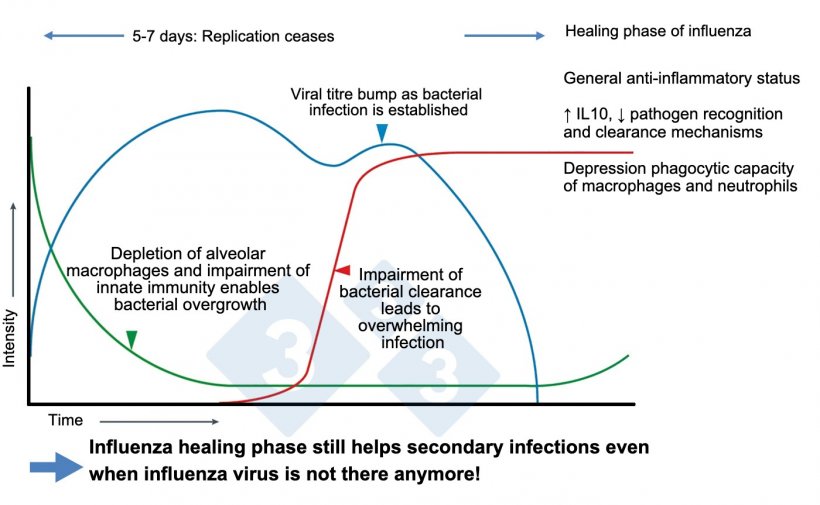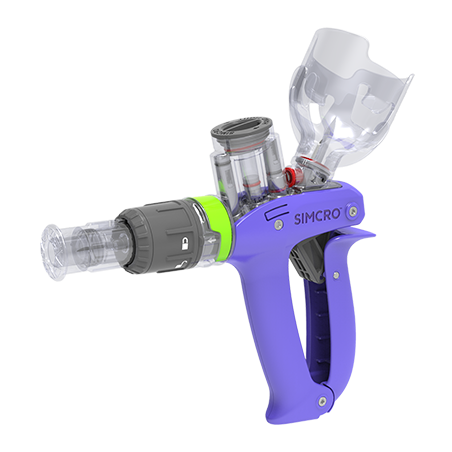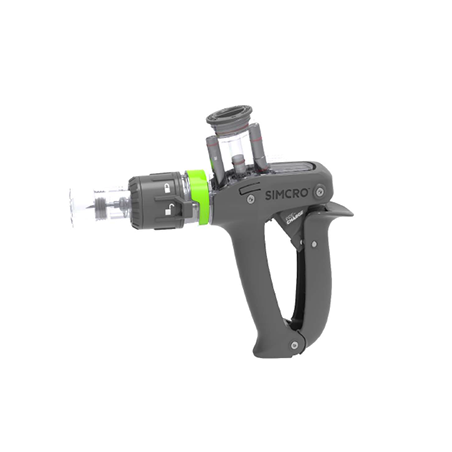Influenza A virus (IAV) is widespread globally in swine and is present on most farms. The subtypes circulating in Europe are H1N1, H1N2, and H3N2, in addition to the pandemic H1N1 strain (H1panN1).
IAV causes the degeneration and death of cells in the respiratory epithelium and causes a rapid inflammatory response with elevated cytokine production, generating an acute airway collapse that blocks airflow in the lungs and leads to bronchointerstitial pneumonia that appears 24-48 hours post-infection.

If the problems were limited to IAV infection, the virus would cease replication in 5-7 days, necrotic cells and inflammation would disappear, and tissues would begin to regenerate, returning to normal around 14-21 days after infection. This situation would be similar to the influenza process affecting people with no secondary complications, where after 3-4 days with relatively severe symptoms, depending on the virulence of the strain and the capacity of the individual's immune system, one recovers without excessive complications.
The most serious problems caused by IAV occur when its effects are complicated by secondary bacterial infections or other primary agents. This is consistent with cases in the humans where most of the 40 million deaths caused by the so called, “Spanish flu” pandemic were related to secondary bacterial pneumonia, since antibiotics were not available, and the hardships of the post-war period contributed to the aggravation of the clinical picture in many patients.
This scenario with the Spanish flu can be partly extrapolated to what we are currently seeing on pig farms, where we regularly see viral circulations (IAV and PRRSV) that coincide with bacteria with different virulence (Bordetella bronchiseptica, Gläesserella parasuis, Streptococcus suis, Mycoplasma hyorhinis, Pasteurella multocida, Mycoplasma hyopnron eumoniae, Actinobacillus pleuropneumoniae, etc.) present on most farms. Often, this coincides with compromised environmental conditions like excessive stocking densities, cold, ventilation problems.
1. Airway obstruction and compromised ciliary movement which creates dead spaces with the ideal conditions for bacterial proliferation (e.g., Streptococcus suis). This results in consolidated lobes filled with bacteria, inflammatory cells, edema, and necrotic cells.
2. Alteration of surfactant by destroying the type II alveolar pneumocytes that produce it This contributes to alveolar collapse the first barrier that prevents infectious agents from being able to pass through the capillaries and reach the bloodstream.
Mechanisms that promote secondary bacterial complications following IAV infection
- Airway obstruction and compromised ciliary movement which creates dead spaces with the ideal conditions for bacterial proliferation (e.g. Streptococcussuis). This results in consolidated lobes filled with bacteria, inflammatory cells, edema, and necrotic cells.
- Alteration of surfactant by destroying the type II alveolar pneumocytes that produce it, which contributes to alveolar collapse taking away the first barrier that prevents infectious agents from being able to pass through the capillaries and reach the bloodstream.
- Increased exposure of receptors for bacteria due to epithelial cell necrosis. Exposure of basal membrane elements (laminin, collagen) or deposits of fibrin and fibrinogen favors the binding of bacterial adhesins. Even the changes that occur during the recovery phase of the lesions also generate adhesion sites. This is why secondary complications beginning after recovery from the primary infection can be observed.
- Hemagglutinin (HA) characteristics: In humans, not all IAV strains exhibit the same level of pathogenicity and this can also be extrapolated to swine. It is known that strains with the ability to bind to α2,3 receptors produce more severe infections by infecting the lower respiratory tract more easily. Strains containing hemagglutinins with a high level of glycosylation bind easier to surfactant, leading to fast elimination of the virus by the cilia. These characteristics explain the high virulent capacity of the 1918 pandemic strain, as it had the capacity to bind to α2,3 receptors and also encloses a low-glycosylated HA, which predisposed to secondary bacterial pneumonia.
- Effects of the virus on immunity against bacteria: IAV consumes alveolar macrophages, which depresses phagocytic activity, and neutrophil-mediated inflammation would cause lesions without achieving effective pathogen control. In addition, a general anti-inflammatory state modulated by IL-10 is established during the healing phase, which suppresses the mechanisms involved in pathogen recognition and clearance, thus depressing the phagocytic capacity of macrophages and neutrophils. As in point 3, this would also help bacterial complications to begin in the recovery phase.
- Potentiation of inflammation: It appears that some IAV strains cause greater cytotoxicity and have a greater capacity to induce inflammation than do others. In addition, bacteria also promote cytokine production, which would increase synergy with IAV.
Figure 1. Modified from McCullers, 2014.
Conclusions
- IAV is a primary pathogen that causes clinical signs, lesions, and problems on its own, and whose degree of pathogenicity differs between strains.
- The severity of problems caused by IAV is strongly related to secondary bacterial infection.
- IAV facilitates the colonization of secondary bacterial agents in the lung that complicate the pneumonia present and open access to other parts of the organism, by facilitating their passage into the bloodstream.
- IAV strains differ in their virulence and ability to contribute to secondary bacterial proliferation. The tissue tropism of IAV (ability to infect the lower respiratory tract) is an important determinant in its pathogenesis.









